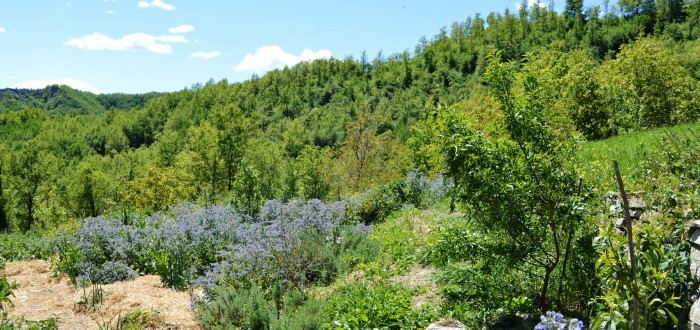A small introduction to Permaculture
Permaculture is a series of techniques that allow us to design and create long-lasting sustainable human settlements. This approach gives us the chance to turn problems into solutions and see the world through new eyes.
The term permaculture was invented by Bill Mollison and David Holmgren in the 1970’s. It originally stood for “Permanent Agriculture”, but the meaning has slightley changed over the years. Permaculture combines the best traditional practices with the best modern technologies and designing methods for sustainability. Its principles can be applied for designing both a farm and the balcony of an aprtment in the city.
Permaculture: what we can learn from nature.
Permaculture is inspired by natural principles and systems that have developed on Earth over thousands of years. Natural systems such as woods are very rich in biodiversity and extremely efficient in terms of recycle of nutrients. They also produce great quantities of biomass and they are SUSTAINABLE in the true sense of the word. Indeed they can sustain themselves for thousands years with no need of herbicides, watering, fertilizers and ploughings.
Let’s compare a wood with a wheat field.
Wheat field
In the picture we see a single species of plant with little or no biodiversity. Everything grows only on one level: the ground level. This cultivation needs herbicides, pesticides, fertilizers and ploughings which lead to erosion caused by wind and rain. Since the 1950’s we have lost 50% of the world cultivable topsoil.
In the wheat field a single disease or parasite can rapidly destroy the plants, while in a system rich in biodiversity such as the wood they can damage one species and leave the rest untouched.
In permaculture we look at the balance and abundance of the wood and we reproduce the same system with edible plants.
Wood
The result is called “Forest Garden”, a place where edible perennial herbs, fruits, nuts, oilseeds (walnuts, hazelnuts, etc.) medical herbs and vegetables are planted with the purpose of creating a highly productive garden that requires very little maintenance. The hardest work is harvesting.
The three ethics and the 12 principles of permaculture
Central to permaculture are the three ethics:
- Earth Care: rebuild natural capital;
- People Care: look after self, kin and community;
- Fair Share: Set limits and redistribute surplus.
The Ethics are the foundations of any permaculture project and they can also be found in most traditional societies.
Permaculture design principles:
The 12 design principles of permaculture are thinking tools, that when used together, allow us to creatively re-design our environment and our behaviour in a world of less energy and resources. These principles are seen as universal, although the methods used to express them will vary greatly according to the place and situation. They are applicable to our personal, economic, social and political reorganisation.
The foundations of permaculture guide the use of the 12 design principles, ensuring that they are used in appropriate ways. Each principle can be thought of as a door that opens into whole systems thinking, providing a different perspective that can be understood at varying levels of depth and application.
1. Observe and interact
Beauty is in the eye of the beholder.
By taking the time to engage with nature we can design solutions that suit our particular situation.
2. Catch and store energy
Make hay while the sun shines.
By developing systems that collect resources when they are abundant, we can use them in times of need.
3. Obtain a yield
You can’t work on an empty stomach.
Ensure that you are getting truly useful rewards as part of the work that you are doing.
4. Apply self-regulation and accept feedback
Le colpe dei padri sono comprese dai figli dopo sette generazioni
Dobbiamo scoraggiare attività non appropriate per assicurarci che il sistema funzioni in modo corretto.
5. Use and value renewable resources and services
Let nature take its course.
Make the best use of nature’s abundance to reduce our consumptive behaviour and dependence on non-renewable resources.
6. Produce no waste
A stitch in time saves nine. Waste not, want not.
By valuing and making use of all the resources that are available to us, nothing goes to waste.
7. Design from patterns to details
Can’t see the forest for the trees.
By stepping back, we can observe patterns in nature and society.
These can form the backbone of our designs, with the details filled in as we go.
8. Integrate rather than segregate
Many hands make light work.
By putting the right things in the right place, relationships develop between them and they support each other.
9. Use small and slow solutions.
The bigger they are, the harder they fall.
Slow and steady wins the race.
Small and slow systems are easier to maintain than big ones, making better use of local resources and produce more sustainable outcomes.
10. Use and value diversity
Don’t put all your eggs in one basket.
Diversity reduces vulnerability to a variety of threats and takes advantage of the unique nature of the environment in which it resides.
11. Use edges & value the marginal
Don’t think you are on the right track just because it’s a well-beaten path.
The interface between things is where the most interesting events take place. These are often the most valuable, diverse and productive elements in the system.
12. Creatively use and respond to change
Vision is not seeing things as they are but as they will be.
We can have a positive impact on inevitable change by carefully observing, and then intervening at the right time.
Key domains of permaculture:
- Building
- Tools and Technology
- Culture and Education
- Health and Spiritual Well-being
- Finances and Economics
- Land tenure and Community Governance
- Land and Nature Stewardship
The spiral evolutionary path suggests knitting together of these domains, initially at the personal and the local level, and then proceeding to the collective and global level.
Does permaculture really work?
Permaculture is applied all over the world. There are many examples or private and public projects, parks, gardens, gerrilla gardening, community vegetable gardens, eroded hills and whole districts that have been redesigned according to permaculture principles. In Italy several ecovillages were born thanks to permaculture design along with many other local experiences.
Permaculture works well because it gives people the chance to take back control of their future by designing it according to their will, instead of accepting other’s people projects. Its principles are easy to learn and follow and the results can be surprising.
If we want to, we can self-produce:
- Vegetables
- Fruits
- Medical herbs
- Flowers
Finally, we do not need to watch helplessly while our environment is degrading, but we can take few practical and simple actions to start making a change.
Newsletter
ARGOMENTI
- Activities (8)
- Attività (10)
- Attrattive (16)
- Cosa fare (22)
- Farm products (4)
- Fattoria dell'autosufficienza (51)
- Fattoria dell'autosufficienza (39)
- Fauna (8)
- Flora (5)
- I nostri modelli (14)
- Istruzioni per viaggiare (2)
- News (63)
- News (96)
- Our models (14)
- Permacultura (30)
- Permaculture (23)
- Prodotti della fattoria (4)
- Senza categoria (2)
- Senza categoria (4)
- Things to do (22)
- Tourist attractions (15)








